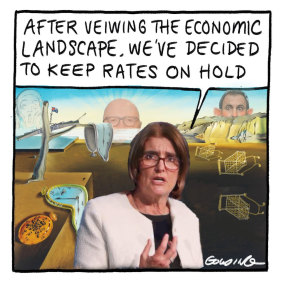
We’re also working fewer hours. In May, those employed worked an average of 135.9 hours – down from 138.7 one year ago. The decrease in average hours worked by each employed person means there are more hours to be shared around. This can make the job market appear stronger than it is because although people might be working fewer hours each, a larger proportion of people may be employed, bringing down the unemployment rate.

Golding’s view.Credit: Matt Golding
In practice, that means a coffee shop might hire two people but reduce the number of hours or shifts each one is rostered on for. Why? Because firing and rehiring can be an expensive and time-consuming process for a business: from issuing redundancy pay, to the recruitment process and handovers. But at least both baristas have jobs, right?
This can lead to an increase in a less visible and less-reported measure of employment: the underemployment rate. This is a measure of the proportion of people working fewer hours than they would ideally like to, and it has risen from 5.7 per cent in May 2022 to 6.7 per cent in May this year.
It’s also important to think about the uneven cost of a weaker jobs market. Young people and those trying to get back into work after a period of time off – such as women looking to return to work after having a child – are disproportionately affected. Youth unemployment – which tends to sit higher than overall unemployment, and is more sensitive to economic conditions – has risen from 7.8 per cent in May last year to 9.7 per cent in May this year. Other measures of employment also show a weaker jobs market. Employment growth and the number of jobs reported to the Australian Taxation Office’s payroll system, while still rising, have both slowed.
Becoming unemployed can have a huge impact on people’s lives: mentally, financially and physically. And the effects can be long-term, especially if the person, facing these stresses, struggles to get back into employment and ends up unemployed for a long time. This in turn can make it trickier for them to find a job later down the track, and can have consequences on those around them. As much as possible, we should make sure to keep people in jobs.
Loading
At 4 per cent, the unemployment rate is getting awfully close to the RBA’s view of the rate at which it thinks the labour market would no longer put upward pressure on wages (and therefore inflation): just above 4 per cent. And we should keep in mind that international supply-side factors and the housing market are probably playing a greater role in bumping up inflation at the moment.
Australia’s relatively low unemployment rate has meant households, for the most part, have been able to support themselves despite higher mortgage repayments and cost-of-living pressures. But it’s not something we can take for granted.
Many renters, young people and those on low-incomes are already feeling the pressure, and even just walking down the street, there has been a noticeable uptick in those sleeping rough.
Bullock’s main quest has been getting inflation within target. But the jobs market is weaker than it looks (with, no doubt, more weakness to come). If the RBA is committed to avoiding recession – and allowing unemployment and underemployment to worsen no more than needed to get inflation down a bit further – the first move to lower interest rates should not be as far off as some fear.
Millie Muroi is a business reporter. Ross Gittins is on leave.
Ross Gittins unpacks the economy in an exclusive subscriber-only newsletter. Sign up to receive it every Tuesday evening.









 Add Category
Add Category